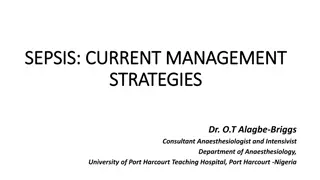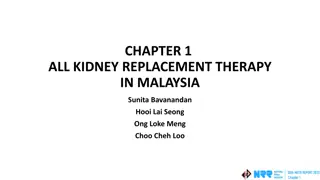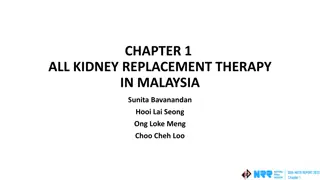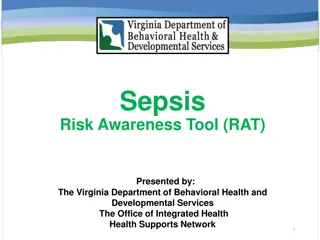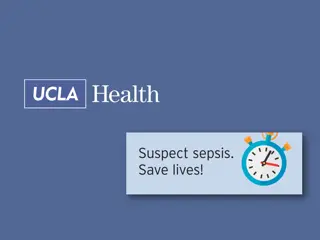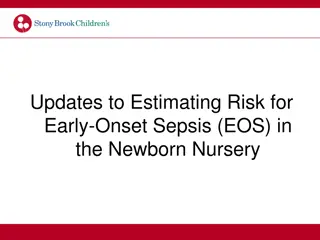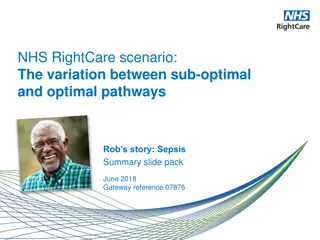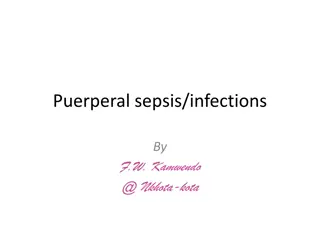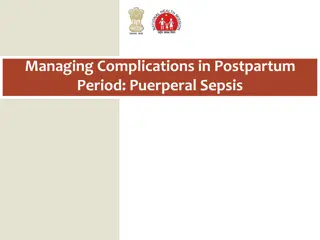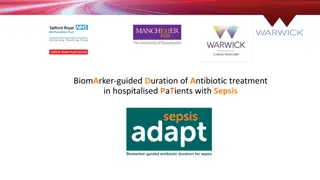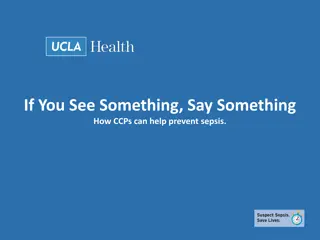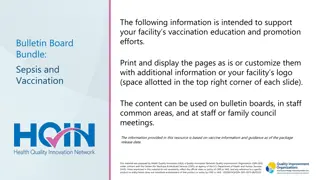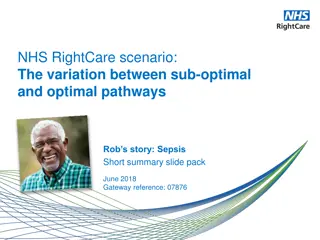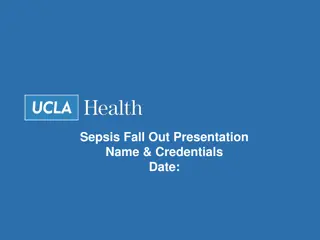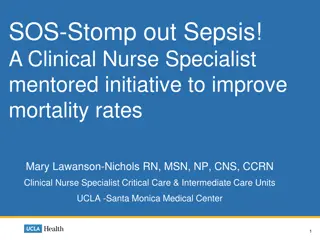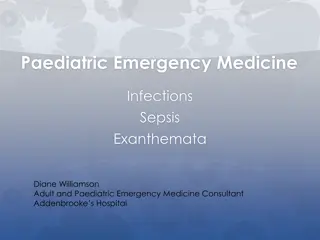Case Study: Sepsis Presentation and Management in Two Patients
Mrs. NP, a 55-year-old woman with a background of cirrhosis from heavy alcohol use, presented to the ED with symptoms suggestive of sepsis. Examination revealed a febrile state, elevated blood pressure, and altered mental status. Investigations were initiated to determine the cause, with differentials including sepsis and meningoencephalitis. Management included antibiotics, antivirals, and steroids. In contrast, Mrs. ML, a 71-year-old woman, presented with headache following a resolved Covid-19 infection. Her examination showed no significant abnormalities. Investigations were mainly unremarkable, suggesting a less severe condition than the previous case.
Download Presentation

Please find below an Image/Link to download the presentation.
The content on the website is provided AS IS for your information and personal use only. It may not be sold, licensed, or shared on other websites without obtaining consent from the author. Download presentation by click this link. If you encounter any issues during the download, it is possible that the publisher has removed the file from their server.
E N D
Presentation Transcript
Sepsis JOSH KIM
Mrs NP 55 year old women Background of cirrhosis from heavy alcohol use Presented to ED with 2/52 hx of headache, vomiting Noted to be drowsy by ambulance
Examination Febrile 40.5 degrees BP 184/102 HR 132 Sats 94% on RA E3V2M5 Intermittently groaning and opens eyes spontaneously Unable to verbalise or give history
Differentials? Sepsis Meningoencephalitis Bacterial- listeria, strep pneumoniae, Neisseria meningitides Viral- HSV1/2, VZV, enterovirus
Investigations Blood cultures Lumbar puncture- protein, glucose, bacterial MCS, Viral NAAT (enterovirus, HSV1 + 2, VZV), bacterial NAAT (listeria, neiserria meningitis, strep pnuemoniae), CSF cryptococcal antigen CTB Baseline bloods EEG
Management Ceftriaxone 2g BD Benzylpenicillin 2.4g Q4hrly Aciclovir 10mg/kg TDS Dexamethasone 10mg IV QID for 5 days
Results CSF glucose <0.1mmol/L CSF protein 11.35 g/L CSF RBC 585 WCC 8865 72% neutrophils Strep pneumoniae DNA detected
Management Cardiac arrest in ED After prolonged attempt at resuscitation, decision to cease treatment
Mrs ML 71 year old Presented with headache, fevers and chills Mild dysuria Covid-19 infection 3 weeks ago, but cleared and improved in symptoms in 1 week BG of migraines Otherwise well and independent
Examination Alert and orientated Febrile 39 degrees, HR 114, BP 132/74 Cardiorespiratory examination unremarkable Abdomen soft non tender Neuro examination- cranial nerves grossly intact Lower + Upper limbs- power 5/5, reflexes normal No neck stiffness/photophobia
Investigations CXR- clear eGFr>90 WCC 12 CRP 116 CT venogram- no thrombus identified. No abnormalities detected
Management Renal US Ampicillin + gentamicin stat dose Treated with 72 hours IV abx and when fevers improved, discharge on additional 7 days of oral abx
Sepsis Sepsis is caused when the body s immune system becomes overactive in response to an infection, causing inflammation which can affect how well other tissues and organs work. Is an syndrome A group of body dysfunctions found together Dysfunctions that progress together in a predictable way High mortality rate, variable clinical presentations National Institute for Health and Care Excellence Guidelines
Septic Shock Sepsis Sepsis + HR>100 RR>20 T > 38 or < 35.5 F Abnormal WBC count Low pCO2 -Hypotension -End organ damage -Elevated lactate Severe sepsis and persistent signs of end organ dysfunction 2 SIRS criteria + Infection Severe Sepsis Mortality 50% SIRS MORTALITY
Normal response to infection Local infection Non-specific inflammatory response 3 phases Vasodilation - increased blood flow to site, infusion of antibodies and cells to fight infection Vessel permeability - antibodies and cells exit bloodstream and enter infected tissue Once infection is controlled, tissue repairs itself
Pathophysiology of Sepsis Uncontrolled, exaggerated immune response Endothelium damage, cell mediator activation, disruption of coagulation system homeostasis Vasodilation and capillary permeability Systemic inflammatory response End-organ damage, death
Risk Factors Extremes of age (old and young) Can t communicate, need careful assessment Patients with developmental delay Cerebral Palsy Recent surgery, invasive procedure, illness, childbirth/pregnancy termination/miscarriage Reduced immunity
Increased Risk for sepsis Diabetes Liver cirrhosis Autoimmune diseases (lupus, rheumatoid arthritis) HIV/AIDS Sickle cell disease Splenectomy patients Compromised skin (chronic wounds, burns, ulcers) Post-organ transplant (bone marrow, solid organ), chemotherapy Chronic steroid use Indwelling catheters of any kind (dialysis, Foley, IV, PICC, PEG tubes, etc)
Exposures Travel History Sexual History Occupational/ Recreational activities Close contacts
Organism virulence Encapsulated organisms Klebsiella pneumoniae Endotoxin
62 year old male in Oncology ward Rapid response- found to be clammy, confused Hypotensive, febrile Mildly hypoxic but bedside CXR clear Urine- has SPC which is cloudy Has a port in situ as receives chemotherapy Treatment??
82 year old male From home alone Worsening SOB + cough Hypoxic to 84% on RA RR 26 Differential + Empirical treatment?
What if this person had recently come back from a holiday in Darwin??
Mr JA 47 year old male Advanced HIV infection- diagnosed at POWH incidental finding whilst under cardiology for AF with RVR on b/g of AVR CD4 count 10, HIV viral load 6170000 copies/ml Commenced on Biktarvy, PJP prophylaxis as outpatient Admitted with AKI, and episode of melena
Overnight CODE BLUE Episode of malaena Hypoxic, hypotensive Differential diagnosis ? Management ?
Progress Vitamin K given after Haem advice Rapid response on ward large volume melaena with hypotension Gastro, cardio, haematology consulted Transferred to HDU Noted hypoxia- on 2L oxygen at the time
Impression Advanced HIV infection - new diagnosis 2022 (CD4 10, on Biktarvy) Dilated cardiomyopathy, metallic AVR Acute kidney injury Multifactorial, improving Severe ulcerative oesophagitis Evidence of candidiasis on endoscopy; co-existing pathology probable (including CMV, HSV) Type 1 respiratory failure Requiring NIV Reported non-productive cough "for weeks", weight loss Pancytopenia
MAC Treatment Hydrocortisone IV 100mg QID Rifabutin 300mg daily Ethambutol 15mg/kg 48hrly Azithromycin 500mg daily Amikacin 10mg/kg stat dose
Learning Points Recognise early signs of sepsis Blood cultures + microbiological diagnosis important Commence empiric antibiotics asap Remember to ask for help! If JMO, Registrar, AT, fellow or even as a consultant
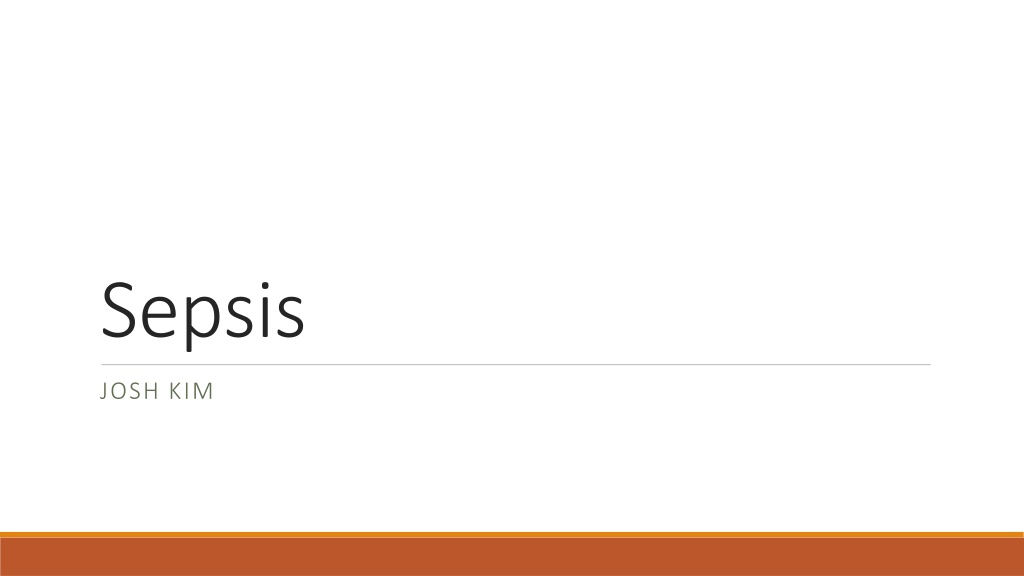
 undefined
undefined



